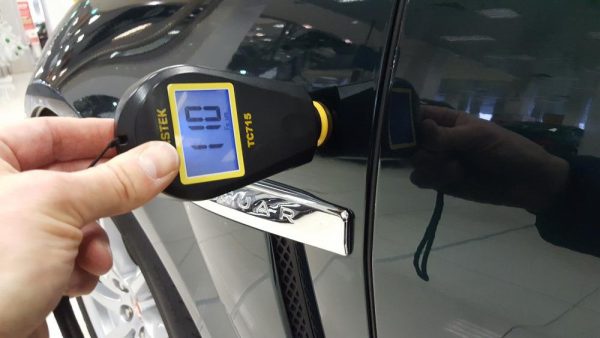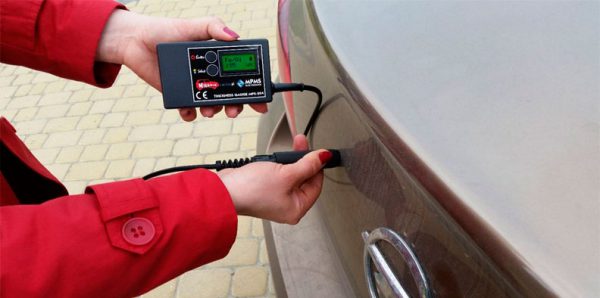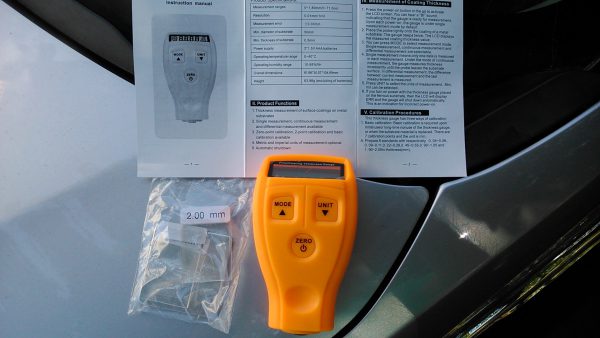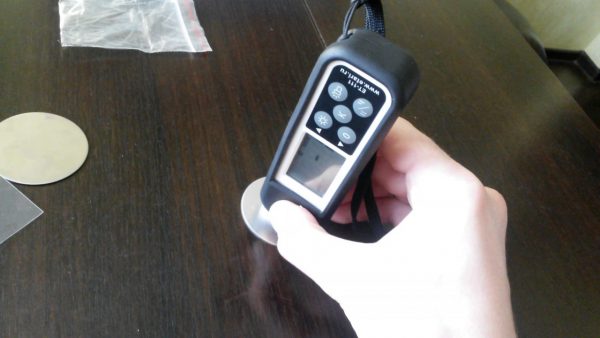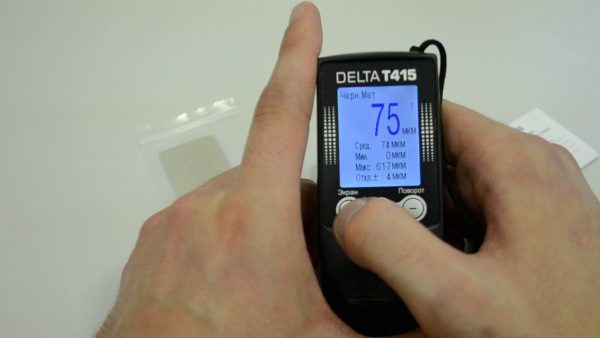When buying a car in the secondary market, it is worthwhile to conduct a thorough check for “skeletons in the cabinet” - the presence of accidents, participation in road accidents with body repairs. Many sellers hide such facts in order not to reduce the price of a car. It is better to get a special device in advance to identify broken and repainted machines - a paint thickness gauge. It will help to detect signs of putty, painting parts and even their complete replacement.
- The use of different thickness gauges
- Non-ferrous metal machine parts
- Thickness Gauge Coatings
- Types of appliances
- Classification
- Graduation by scope
- Functional classification
- Choice - basic and additional criteria
- Measurement procedure
- The best thickness gauges
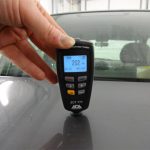
The use of different thickness gauges
LKP thickness gauge - a device measuring a layer of paint on the surface of a machine. It allows you to check the number of layers of paint and compare with factory settings. The paint thickness gauge helps to measure the distance from the sensor to the metal (body base). Unfortunately, in the principles of work there are also disadvantages of devices, since their use is not possible on all grounds.
The easiest way to use the meter is if the base is steel (ferromagnetic). Even the simplest device will allow you to get accurate readings, so you should not spend money on an expensive thickness gauge. But if the device works only on the electromagnetic principle, it cannot be used on coatings other than ferromagnets. The latter include all iron-steel alloys.
Here are other recommendations when using thickness gauges on different coatings:
- Vortex devices are better suited for thickness measurement of automotive paintwork from copper, aluminum, bronze and their alloys, while on ferromagnetic bases they reduce accuracy;
- thickness gauges with an electromagnetic vortex principle of action work on all metal coatings;
- ultrasonic (echolocation) devices measure the thickness of any coatings, their principle of operation does not depend on the material of the parts.
to contents ↑Thus, to check the integrity of plastic, composite plastic products, you need to choose ultrasonic devices - only they will help to inspect the machine and get the correct results.
Non-ferrous metal machine parts
There are tables in which the material details of automobiles of a particular brand are indicated. Here is an overview of models in the production of which non-ferrous metals are used:
| Mark | Model | Details from colormet |
|---|---|---|
| BMW | Z8,7 | Body |
| 3,5,6 | Hood, body, doors | |
| X5, X6 | Hood, body | |
| Chevrolet | Venture | Hood |
| Suburban | Body | |
| Ford | Most models | Hood |
| Infiniti | Q series, I | Hood, trunk |
| Mercedes Benz | CL500, SL500 | Wings, trunk, hood, body, doors |
| Subaru | GT, Legacy | Hood |
| Peugeut | 407 | Hood |
Thickness Gauge Coatings
Using a thickness gauge, it is possible to check different coatings, because various types of paints and varnishes are applied to the bases of metal or composite. Also, the device will include in the measured indicators all kinds of primers, fillers. The device will also respond to rust accumulations, as well as to the ceramic coating applied on top.
to contents ↑Limitations in the measurement of data exist for all devices using the magnetic or electrical principle of operation. The upper LPC should be dielectric in properties, and also have a smooth clean surface. That is, a metal base and a dielectric coating are a prerequisite for obtaining accurate data. These are the requirements that most cars manufactured by the modern automotive industry meet.
Types of appliances
Which instrument for measuring the thickness of the car paintwork is better? The choice is large, and the devices are grouped according to different principles.
Classification
According to the overall performance, all models can be conditionally divided into the following classes:
- First grade. They are characterized by low cost, quite reliable, but the set of their functions is limited. Using devices is usually not very convenient, for beginners there may be difficulties.
- Second class. It’s easier to work, but slow. Differ in higher accuracy of measurements, than models of the previous class
- Third class. More expensive devices outperform previous ones. They have a large set of functions. The disadvantage of using meters is also there - they require regular calibration, and can also give incorrect information at low outdoor temperatures.
Graduation by scope
The scope of use of thickness gauges is extensive. They are used in insurance (for assessing car damage), the construction industry, the automotive industry, shipbuilding, and the aviation industry. Any master in painting and tuning a car always has such a device. Meters are bought by private individuals, firms, and for the purpose of examination they always choose the most modern devices - high-precision, with the ability to measure the thickness of the paintwork up to fractions of a micron. For household purposes, you can purchase a simpler thickness gauge.
to contents ↑Functional classification
The simplest and most popular in everyday life is a magnetic thickness gauge. A magnet is built into its body, which determines the degree of proximity of the location of the metal or alloy. Indications will be visible on the instrument panel or, if it is mechanical, are indicated by an arrow. Inside the electronic devices is a strain gauge.
Other types of thickness gauges are as follows:
- Electromagnetic Work by means of current induction. The car body serves as a closed circuit, while measuring the density of the magnetic field, according to which the device gives a result about the thickness of the paintwork.
- Eddy current. They work well with aluminum, measuring the power of the currents induced inside the part. Since other types of metals have a different conductivity, the gap between the sensor and the part (thickness of the paintwork) may not reflect correctly on the screen.
- Combined. They give good accuracy of the results, since they combine the presence of eddy current and electromagnetic sensors.
- Ultrasonic They give impulses to the surface of the body, are suitable for all types of materials, and are used even in hard-to-reach areas. Have the highest price.
There are also mechanical thickness gauges, but they are now almost never used due to the extremely low accuracy. Such devices will be able to determine, except that, a thick layer of putty, which has lain on the part for many years.
to contents ↑Choice - basic and additional criteria
How to choose a thickness gauge, which is the best? A huge number of models are sold on the market - new and old, with improvements. Their cost is diverse, as are properties, the principle of action. When buying, first of all, you need to determine how and how much the device will work. If you intend to use it once, only for buying a car, it is better to take an inexpensive thickness gauge, but at the same time take into account the necessary measurement accuracy.Professionals usually do not save and buy high-quality meters, paying attention to the sensitivity of the device, the number of modes, functions, percentage error.
To check the thickness of the coating without attracting the attention of the seller, it is worth choosing a small device in the form of a key fob or marker (usually these are magnetic thickness gauges). Additional functions that are selected according to individual preferences are as follows:
- the presence of sensors for measuring the thickness of fiberglass, rubber;
- determination of the degree of metal corrosion;
- the ability to work under water;
- automatic shutdown with long inactivity;
- language selection;
- sound notification.
Many will come in handy an additional option - backlight. It will allow you to assess the condition of the machine even at dusk or in the dark, which is important for the cold season. Also, when buying, you should pay attention to the weight and dimensions of the thickness gauge, the time of continuous service, the material of the case (for long-term operation, the latter must be durable and have a protective cover).
It must also be remembered that all electronic devices work better in the room, and magnetic ones are independent of humidity and temperature, therefore they are also suitable for the street. In appearance, there are trigger gauges, classic with a button, in the shape of a gun, the first being the most popular.
to contents ↑Measurement procedure
How to use the thickness gauge is always indicated in the instructions for use. You should read all the data in advance, familiarize yourself with the properties of the device. Also at home, you need to calibrate the device to obtain accurate data. There are also self-calibrating thickness gauges, but they usually give less detailed information. Calibration is done manually to bring the instrument closer to the reference measurement.
Complete with a thickness gauge there are several calibration plates - metal or plastic. The former play the role of the body, the latter play its role. A metal plate can be taken in another place, the main thing is to choose exactly the material for which the device is designed. Its surface should be smooth and clean. Plastic plates cannot be changed to their own. For calibration, the readings are reset to the factory settings, they are measured on a metal plate, the “zero” key is pressed (or another according to the instructions). If the error level is zero, calibration is not required. Otherwise, do the calibration. The algorithm is as follows:
- attach a metal plate to a plastic one;
- make a measurement;
- press the calibration key - K;
- align the value on the screen to 102 microns;
- press K. again
Then you can work with a thickness gauge. It is pressed to the test base, after which you can see the numbers on the screen. The sensor must be in close contact with the enamel. It is better to examine the body pointwise (on each part - 4-5 points), but some use the continuous mode (they lead the device along the surface). After that you can calculate the arithmetic mean for all body parts.
to contents ↑The indicators judge the presence or absence of discrepancies with the factory parameters. On average, for most cars they are 70-150 microns, most often 80-130 microns. For symmetrical objects, the value should be the same, but in different places on the body it can vary slightly. The maximum deviation is up to 50 microns, on average - up to 25 microns (plus the error of the device - 2-4%).
The best thickness gauges
Below are the models of thickness gauges that users liked, they have a good price-quality ratio, as well as decent functionality:
- Etari ET 555. Combined device with reduced power consumption, allowing you to save settings. It has a unique backlight, comfortable for the eyes.
- IT-01.Magnetic device, well measures the thickness of the coating of steel bodies. Easy to use, has a powerful flashlight. Not suitable for continuous testing because of the risk of scratching the car.
- ET-14. A professional device, there is a control of modes, calibration. Results can be downloaded to a computer via USB. Suitable for iron and color meters.
- ET-11S. Equipped with a combined sensor with eddy current and electromagnetic operating principles. Good for steel and aluminum.
- CHY 113. An electromagnetic device, suitable for work on ferrous metals. Included are discs for calibration. The sensor with a spring, which guarantees stable clamping force to the body.
- Delta T-415. Compact, accurate magnetic device with a small internal memory. It works properly in the cold, the battery capacity lasts a long time.
- "Megeon 19220". An ultrasonic device that provides accurate measurement of the thickness of any paintwork. It has a liquid crystal display, comfortable lighting and a storage case.
It should be remembered that even the most accurate device can be fooled, for example, if you do not wash the car. In this case, the thickness of the paint will be incorrect. A number of cars from the premium segment have a much higher coating thickness (up to 250 microns), which should also be taken into account. The coverage of very old cars that have been to the sink many times is thinning. All this information will help you not to get confused when taking measurements and make the right conclusions about the purchased car.

